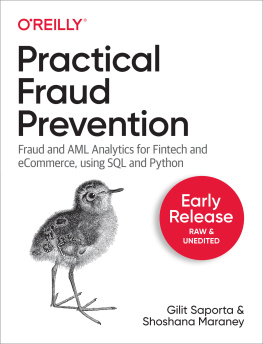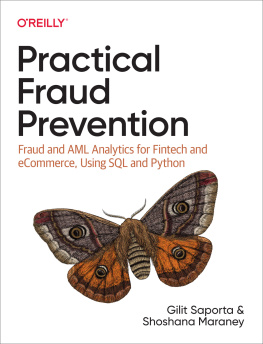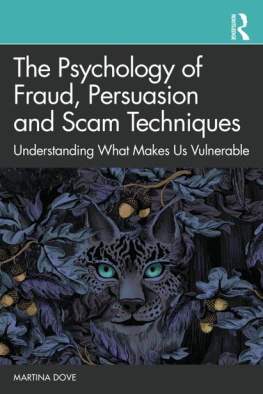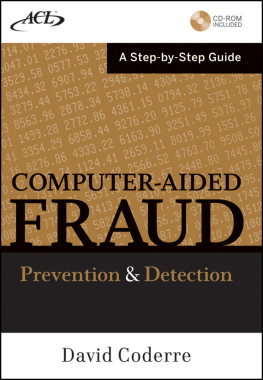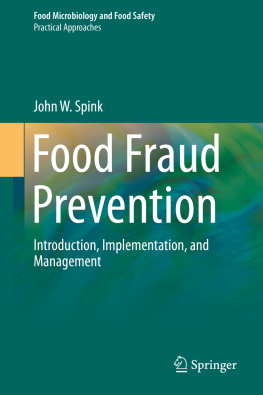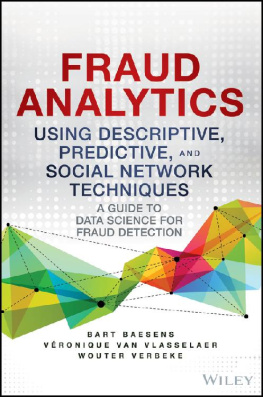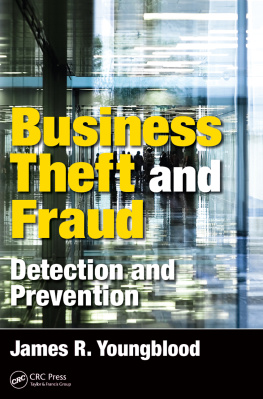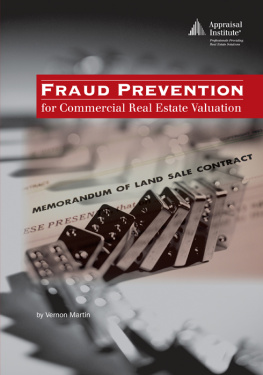Gilit Saporta - Practical Fraud Prevention
Here you can read online Gilit Saporta - Practical Fraud Prevention full text of the book (entire story) in english for free. Download pdf and epub, get meaning, cover and reviews about this ebook. year: 2022, publisher: OReilly Media, Inc., genre: Home and family. Description of the work, (preface) as well as reviews are available. Best literature library LitArk.com created for fans of good reading and offers a wide selection of genres:
Romance novel
Science fiction
Adventure
Detective
Science
History
Home and family
Prose
Art
Politics
Computer
Non-fiction
Religion
Business
Children
Humor
Choose a favorite category and find really read worthwhile books. Enjoy immersion in the world of imagination, feel the emotions of the characters or learn something new for yourself, make an fascinating discovery.
- Book:Practical Fraud Prevention
- Author:
- Publisher:OReilly Media, Inc.
- Genre:
- Year:2022
- Rating:3 / 5
- Favourites:Add to favourites
- Your mark:
- 60
- 1
- 2
- 3
- 4
- 5
Practical Fraud Prevention: summary, description and annotation
We offer to read an annotation, description, summary or preface (depends on what the author of the book "Practical Fraud Prevention" wrote himself). If you haven't found the necessary information about the book — write in the comments, we will try to find it.
Gilit Saporta: author's other books
Who wrote Practical Fraud Prevention? Find out the surname, the name of the author of the book and a list of all author's works by series.
Practical Fraud Prevention — read online for free the complete book (whole text) full work
Below is the text of the book, divided by pages. System saving the place of the last page read, allows you to conveniently read the book "Practical Fraud Prevention" online for free, without having to search again every time where you left off. Put a bookmark, and you can go to the page where you finished reading at any time.
Font size:
Interval:
Bookmark:

by Gilit Saporta and Shoshana Maraney
Copyright 2022 Gilit Saporta and Shoshana Maraney. All rights reserved.
Printed in the United States of America.
Published by OReilly Media, Inc. , 1005 Gravenstein Highway North, Sebastopol, CA 95472.
OReilly books may be purchased for educational, business, or sales promotional use. Online editions are also available for most titles (http://oreilly.com). For more information, contact our corporate/institutional sales department: 800-998-9938 or corporate@oreilly.com .
- Acquisitions Editor: Michelle Smith
- Development Editor: Corbin Collins
- Production Editor: Kate Galloway
- Interior Designer: David Futato
- Cover Designer: Karen Montgomery
- Illustrator: Kate Dullea
- April 2022: First Edition
- 2021-03-05: First Release
- 2021-06-22: Second Release
See http://oreilly.com/catalog/errata.csp?isbn=9781492093329 for release details.
The OReilly logo is a registered trademark of OReilly Media, Inc. Practical Fraud Prevention, the cover image, and related trade dress are trademarks of OReilly Media, Inc.
The views expressed in this work are those of the authors, and do not represent the publishers views. While the publisher and the authors have used good faith efforts to ensure that the information and instructions contained in this work are accurate, the publisher and the authors disclaim all responsibility for errors or omissions, including without limitation responsibility for damages resulting from the use of or reliance on this work. Use of the information and instructions contained in this work is at your own risk. If any code samples or other technology this work contains or describes is subject to open source licenses or the intellectual property rights of others, it is your responsibility to ensure that your use thereof complies with such licenses and/or rights.
978-1-492-09325-1
With Early Release ebooks, you get books in their earliest formthe authors raw and unedited content as they writeso you can take advantage of these technologies long before the official release of these titles.
This will be the 2nd chapter of the final book.
If you have comments about how we might improve the content and/or examples in this book, or if you notice missing material within this chapter, please reach out to the editor at ccollins@oreily.com.
If you were trying to pin down the main difference between an analyst who works extensively with data, and a data scientist, youd likely touch on the concept of domain expertise as a key value that analysts bring to the table. Data is enormously valuable, but it wont get the results youre looking for without a deep understanding of the context. This is particularly important with fraud fighting, since youre fighting an enemy that actively fights back, changing its techniques and patterns to evade detection and trying to reverse engineer and thus avoid the traps youve created to catch them. You dont want to wait until you have a lot of data about a new attack type or new fraud ring; you want to catch it before that.
Fraud domain experts are often the ones to provide the secret sauce, those impactful variables that really boost the performance of a fraud prediction model. If we had to narrow down that secret sauce, that domain expertise that every fraud analyst should hone to perfection, wed say that it ultimately comes down to fraudster profiling. A good analyst helps her team understand that not all fraudsters are created equal. Some of them are amateurs; others are pros. Some of them are native speakers of the language of their victims; others rely on auto-translate. Some are very tech-savvy, so trying to beat them with checkout barriers would be futile (e.g. if theyre using brute force bots, captcha would be counter-productive).
Therefore, its essential to learn how to group fraud attacks based on the guesstimated profile of the human being behind them. Its worth mentioning that user profiling in general is a powerful analytic practice. Many departments seek to better understand their target audience by breaking down the group theyre speaking to into approximate groups, each one of which has specific characteristics, behaviors and pain points. Discussing the groupings theyre using with marketing, sales or product teams can actually be a good, regular touchpoint for fraud teams to get together with other departments and build lasting, mutually beneficial relationships. It can also help your team work to avoid false positives.
That said, a fraud teams key target audience is rather different. A fraud analyst is primarily focused on fraudsters. Breaking down the types of fraudsters your team is facing, and which characteristics each is likely to show, helps the team to identify and block each type, working out which ones most regularly attack your business. This should contribute to your strategy for how to prevent fraud both now and in the future, may help you work out where to invest most research, resources or new tools, and can even lead to insights about how and why your business is most vulnerable to fraud - and, therefore, what you could do to make yourself a less attractive target.
In this chapter, we cover some of the most common fraudster archetypes. We hope that this will provide you with a useful mental framework for understanding the online criminals you work against, as well as the practical strategic help as described above. Some will be more or less relevant to you depending on your industry (banks are more likely to be targeted by Psychological Fraudsters than by Amateur Fraudsters, for example) but there are no hard and fast rules for this, and we encourage you to be aware of all of these archetypes so you can protect against them should they attack you.
It is important to bear in mind, however, that these are archetypes, not actual people, that were discussing; so dont expect every single fraudster to conform to type in every single way, every time. In particular, you need to remember that these days fraudsters rarely work alone, so you may often have more than one archetype in play as part of a large coordinated attack. Even amateur fraudsters work in groups or spend time on online forums learning from and sharing experiences with other fraudsters-in-training, and they benefit from guides and burnt cards made available by more experienced fraudsters. Mechanical Turk style fraudsters are only really a threat because they operate as cogs in a larger fraud machine, guided by managers and fueled with data stolen by other criminals.
Many fraudsters, particularly those for whom fraud is their profession, work as part of an organized criminal initiative, with colleagues who specialize in areas such as botnets, phishing campaigns or design (to create convincing fake websites and ads), to name just a few. Larger organizations boast their own financial and even HR officers. There are also consultants who can be hired. Online fraud is a big business.
The most common type of fraudster, and the easiest to spot, is the amateur fraudster. This is either someone who has only recently entered the world of online fraud, or someone who engages in fraud as a side job or hobby rather than a profession. This can include young people attempting a bit of fraud without really understanding the criminal nature of the enterprise (its something theyve seen on TV) or attempting to steal items currently popular among their cohort which are out of their price range.
Font size:
Interval:
Bookmark:
Similar books «Practical Fraud Prevention»
Look at similar books to Practical Fraud Prevention. We have selected literature similar in name and meaning in the hope of providing readers with more options to find new, interesting, not yet read works.
Discussion, reviews of the book Practical Fraud Prevention and just readers' own opinions. Leave your comments, write what you think about the work, its meaning or the main characters. Specify what exactly you liked and what you didn't like, and why you think so.

